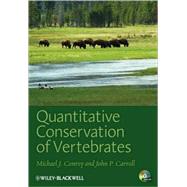
Note: Supplemental materials are not guaranteed with Rental or Used book purchases.
Purchase Benefits
What is included with this book?
Dr John P. Carroll has been researching conservation issues relative to the Galliformes for more than 20 years. He is Chair of the World Pheasant Association/BirdLife/IUCN Species Survival Commission Partridge, Quail, and Francolin Specialist Group. He is author of numerous publications on the biology and conservation of Galliformes and the effects of agricultural practices on wildlife. He is currently Professor of Wildlife Ecology and Management in the Warnell School of Forestry and Natural Resources at the University of Georgia. He has taught short courses on field research methods and techniques in Malaysia, Nepal, and India.
| Preface | p. vii |
| Acknowledgements | p. ix |
| Companion website and CD-ROM | p. x |
| Introduction: the role of science in conservation | p. 1 |
| Basic concepts in scientific investigations for conservation | p. 7 |
| Using models in conservation biology | p. 9 |
| Models of population dynamics | p. 15 |
| Applying population models to conservation | p. 32 |
| Basics of study design and analysis | p. 47 |
| Conservation studies and monitoring programs | p. 71 |
| General principles of estimation | p. 73 |
| Occupancy (presence-Absence) analysis | p. 81 |
| Sample counts for abundance estimation | p. 101 |
| Distance sampling for estimating density and abundance | p. 115 |
| Capture-mark-recapture studies for estimating abundance and density | p. 135 |
| Estimation of survival from radiotelemetry, nesting success studies, and age distributions | p. 160 |
| Mack-recapture for estimating survival, recruitment, abundance, and movement rates | p. 189 |
| Analysis of habitat | p. 219 |
| Estimation of species richness and other community parameters | p. 230 |
| Integrating modeling monitoring for conservation | p. 251 |
| Elements of conservation decision making | p. 253 |
| Accounting for uncertainty in conservation decisions | p. 265 |
| Learning and adaptive management | p. 274 |
| Case study: decision modeling and adaptive management for declining grassland birds in the southeastern USA | p. 289 |
| Summary and recommendations | p. 303 |
| Literature cited | p. 307 |
| Glossary | p. 314 |
| Statistical and modeling programs available on the worldwide web | p. 324 |
| Other internet resources | p. 326 |
| Modeling and statistical notation | p. 328 |
| Key to abundance and parameter estimation | p. 331 |
| Index | p. 337 |
| Table of Contents provided by Ingram. All Rights Reserved. |
The New copy of this book will include any supplemental materials advertised. Please check the title of the book to determine if it should include any access cards, study guides, lab manuals, CDs, etc.
The Used, Rental and eBook copies of this book are not guaranteed to include any supplemental materials. Typically, only the book itself is included. This is true even if the title states it includes any access cards, study guides, lab manuals, CDs, etc.